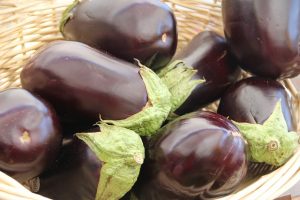The eggplant is a staple of the Mediterranean kitchen, but it is also becoming increasingly familiar to American diners. And that gives cooks an extremely versatile food with which to work.
Eating a wide variety of vegetables and fruits is one of the most important steps you can take to protect your health, according to the American Institute for Cancer Research. Although usually considered a vegetable, the eggplant is actually a fruit. It is a member of the nightshade family, making it a relative of the potato and tomato. All these vegetables are considered nutritious sources of vitamins and cancer-fighting phytochemicals.
While eggplant, which originated in India, is available year round, its peak season is in August and September. And when it's really fresh, eggplant has a sweet, mild flavor. You can eat the skin of young, fresh eggplant, but older ones should be peeled. Since the flesh discolors rapidly, an eggplant should be cut just before using.
The many varieties of eggplant range from deep purple to white, from oblong to round and in lengths from 2 to 12 inches in length. The lighter the color, the milder the eggplant, with white being the mildest. The narrow Japanese or Asian eggplant is tender and sweet. The egg-shaped white eggplant has a tough skin and smooth flesh. Americans are most familiar with the large, purple eggplant.
Select an eggplant that's heavy for its size and has a firm, smooth skin. Avoid those with brown or soft spots. Eggplants are very perishable and become bitter with age. Store them in a cool, dry place and use within a day or two of purchase. If you must store them longer, put them in the vegetable drawer of your refrigerator.
Content Continues Below ⤵ ↷
Eggplant can be baked, broiled, or fried. Baba ghanoush, a Middle Eastern classic, combines roasted and pureed eggplant with a touch of olive oil plus garlic and other seasonings. It makes a hearty dip or spread to serve with pita bread or whole-grain crackers.
Baba Ghanoush
Makes about 2-1/2 cups.
- 1 medium eggplant (about 1 lb.)
- 1 small onion, cut into fourths
- 1-2 large cloves garlic (or to taste), finely minced
- 2 Tbsp. fresh lemon juice
- 1 Tbsp. extra virgin olive oil
- Salt and freshly-ground black pepper, to taste
- 2 Tbsp. flat-leaf parsley, finely chopped
- Heat the oven to 400 degrees.
- With a fork, pierce eggplant in 3 or 4 places. Place on a rack set in a baking sheet. Bake about 40 minutes or until soft. Set aside to cool. Peel eggplant and cut into cubes.
- Place eggplant, onion, garlic, lemon juice, oil, salt and pepper in a food processor or blender. Cover and puree until smooth, stopping to scrape down sides of container if necessary. Check seasoning and add more salt to taste, if desired. Drain excess liquid and spoon mixture into a bowl. Garnish with parsley.
- Serve the baba ghanoush with whole-grain pita bread wedges.
Per 1/4 cup serving:
27 calories,
1 g. total fat (less than 1 g. saturated fat),
4 g. carbohydrate,
1 g. protein,
1 g. dietary fiber,
2 mg. sodium.
Diabetic Exchanges:1 Vegetable
AICR
